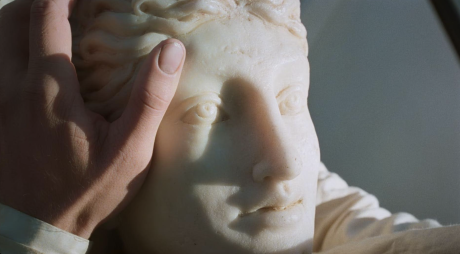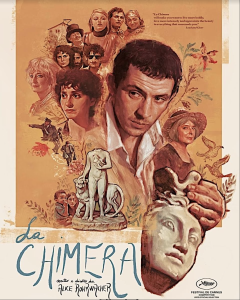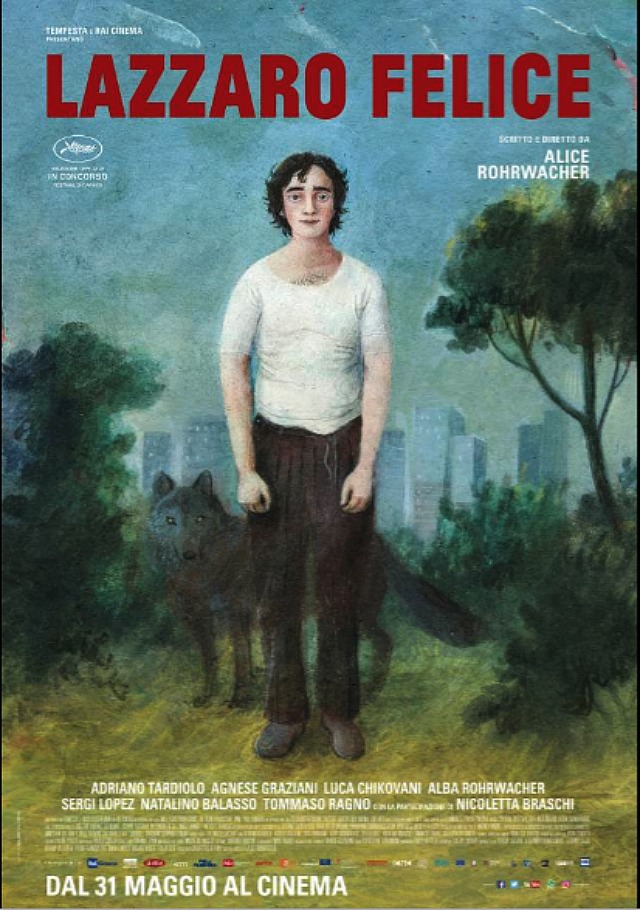I missed Alice Rohrwacher‘s La Chimera at last year’s Cannes Film Festival and then again in Telluride eight months ago, but I finally saw it at the Jacob Burns on Sunday night and man, it has a real unwashed, hand-to-mouth, transportational spirit thing going on.
It’s about the ancient past (Etruscan artifacts) being dug up in Tuscany and sold and exploited by lowlife scruffs, and how this all shakes down in a moralistic or fable-like sense. It doesn’t pay off emotionally, or at least not in a way that I recognize, but it almost does. And it definitely feels whole by the end — I can say that for sure.
Rohrwacher, her dp Hélene Louvart (who mostly shoots within 1.37 and 1.66 aspect ratios), editor Nelly Quettier and the mostly tramp-like, generally unattractive cast (except for the radiant Carol Duarte, a Brazilian actress playing a kind of Gelsomina- or Guilietta Masina-like innocent, and the white-haired, eternally beautiful Isabella Rosellini)…Rohrwacher and friends are definitely up to something here.
Tall, pale-faced, unshaven Josh O’Connor plays Arthur, a kind of artifact whisperer — a filthy British-born bilingual fellow who smokes all the time, wears dirty clothing and ugly footwear and shuffles around with one of the worst haircuts in movie history.
But Arthur is about more than just stinky socks and rancid cigarette breath — he can sense or smell where Etruscan artifacts (sculpture, goblets, statues, frescoes) are buried, and so most of the film is about Josh guiding a band of tomb robbers on illegal digs. Their findings are sold to a sinister art dealer (Alba Rohrwacher, the director’s older sister), and that’s how they make ends meet.
La Chimera is about hundreds upon hundreds of spirit elements coexisiting in a hungry, dirt-poor realm without showers or deodorants or laundromats…the soiling and pirating of ancient remnants by low-life scuzzies…buried Etruscan pottery and tiled floors and erotic figurines…soil whispers, dusty ghosts.
Ethical conflicts abound, of course, but what matters is treating the past with care and reverence and allowing others to bask in its beauty. I don’t see what’s so bad about selling found history. As long as the artifacts are respected and not hoarded, what’s the problem?
It took me a good half hour before I got past O’Connor’s smelly feet and disgusting cigarette smoking and began to realize where the film is headed — before it hit me that it’s a casting a kind of underclass spell that really takes hold…that it’s a La Strada-like adventure or dirt poem, a half-fantasy or fairy tale about wretched refuse types looking to survive as best they can and not fretting about ethical issues…about digging up Etruscan pots and cups and marble statues and you-name-it…poor folks sifting through soil in Tuscany’s hidden regions (i.e., the kind that tourists rarely gaze upon).
Talk about a curious turn-on mechanism but this is Rohrwacher’s signature…she takes all kind of disparate, haunting, non-hygenic elements and throws them together like a salad maker…nothing is the least bit glammy or posed or polished or conventionally alluring…everything is half-assed, raggedy-assed…the sublime merged with the ugly.
La Chimera features one of the ugliest coastline super-sized factories I’ve ever seen in my life — it reminded me of a coastline factory in Piombino, a working-class town where tourists catch the ferry to Elba.
La Chimera has a real sense of spirit. Rohrwacher (her first name is pronounced Ahh-LEE-chuh) really goes for the off-handed, the weird, the gunky, the untidy, the muddy. It’s not exactly pleasant, but is kind of wonderful all the same.


Filed on 5.14.18: Alice Rohrwacher‘s Happy as Lazzaro may win the Cannes Film Festival’s Palme d’Or next weekend. It’ll almost certainly win something big as it’s quite the spiritual film, and it delivers the kind of humanist current that can lift all boats.
In this stand-up-for-women moment on the Cote d’Azur, the deciding factor, I suspect, may simply be one of gender. I’m not saying Happy as Lazzaro is a woman’s film — the spiritual current is universal and gender-less — but it’s very much a “heart” film, and I’m sensing that this plus a “let’s give the big prize to a woman director if we can” factor will penetrate.
Set sometime in the late ’80s, Rohrwacher’s third film is about a late-teen or twentysomething farmworker named Lazzaro (Adriano Tardiolo), who at first resembles a cross between a pure-of-heart innocent or, if you want to brusque about it, a seemingly charmed simpleton. But that impression changes as the film develops, especially during the second half.

While Happy as Lazarro takes place in two distinctly different realms, they share a tone of exploitive cruelty and a look at the harsh plight of the hurting poor — a rural and almost medieval tobacco farm in central Italy in the first half and a large Italian city in the second half.
The dividing line between the two is a startling event that happens halfway through, and after this the true scheme of Happy as Lazzaro kicks in.
For this is basically the story of a kind of saint who refuses to respond with even a trace of guile or calculation. Lazzaro is very much a lamb-like (or donkey-like if you consider his resemblance to the Christ-like beast in Bresson’s Au Hasard, Balthazar) figure of faith and trust, and the resulting current of kindness and compassion becomes more and more affecting.
Happy as Lazzaro is my second favorite film of the festival so far, second only to Pawel Pawlikowski‘s Cold War. It’s quite the mixture of fabulism and a certain kind of grim, social-critique drama, shot in 16mm with a hand-held, rounded-edges aesthetic.
I’m not saying Rohrwacher is copying anyone, but I felt the influence of the Taviani brothers‘ Padre Padrone and Bernardo Bertolucci‘s 1900 in the first half, and then a whole different kettle of fish (urban poverty) in the second half. But it’s always about purity vs. venality and indifference, and it’s really quite magical.
Among the costars are Alba Rohrwacher (the director’s older sister) and Spanish actor Sergi Lopez (Pan’s Labyrinth), whom I didn’t even recognize at first.
The rural portion (i.e., the first half) was shot in Bagnoregio, a small commune in the Lazio section of Italy.
